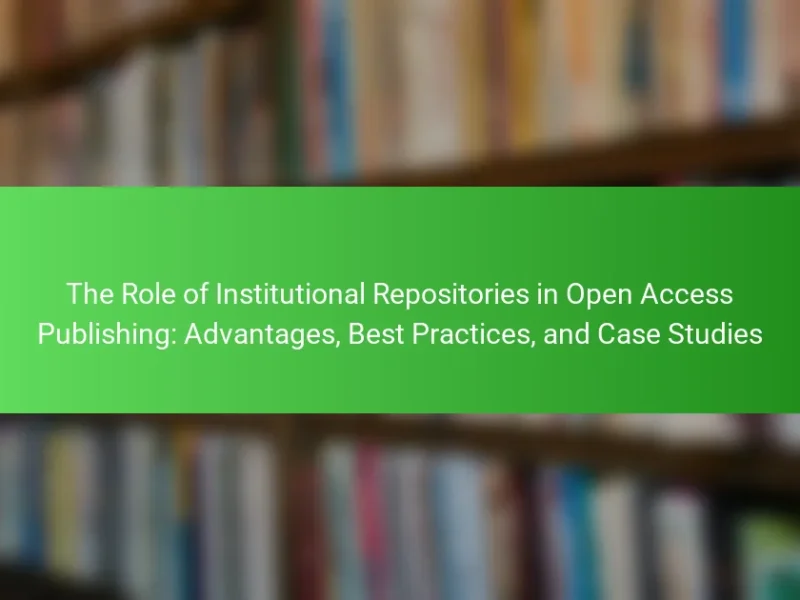Open Access is a model that provides unrestricted access to scientific research outputs, promoting equity in science by eliminating financial barriers for researchers and the public. This article explores the benefits of Open Access, including increased citation rates, wider dissemination of knowledge, and enhanced collaboration among diverse researchers. It also addresses the challenges faced in achieving equitable access, such as funding disparities, varying journal quality, and limited awareness among researchers. Additionally, the article highlights successful Open Access initiatives like the Public Library of Science (PLOS), the Directory of Open Access Journals (DOAJ), and African Journals Online (AJOL), which collectively contribute to a more inclusive scientific community.

What is the role of Open Access in promoting equity in science?
Open Access plays a crucial role in promoting equity in science by providing unrestricted access to research outputs. This model eliminates financial barriers for researchers, institutions, and the public. Open Access enables wider dissemination of knowledge, allowing all individuals, regardless of their economic status, to access scientific information. According to a study by the International Association of Scientific, Technical and Medical Publishers, Open Access increases citation rates, leading to greater visibility and impact of research. Furthermore, it fosters collaboration among researchers from diverse backgrounds, enhancing innovation. By democratizing access to scientific knowledge, Open Access promotes inclusivity and equity in the scientific community.
How does Open Access contribute to equitable access to scientific knowledge?
Open Access contributes to equitable access to scientific knowledge by removing financial barriers to research publications. It allows anyone, regardless of their institutional affiliation or economic status, to access scholarly articles. This democratization of information supports researchers and practitioners in low-income countries. According to the Directory of Open Access Journals (DOAJ), over 15,000 journals provide free access to their content. Open Access also fosters collaboration across diverse communities. This inclusivity can lead to innovative solutions addressing global challenges. Furthermore, studies show that Open Access articles are cited more frequently than subscription-based articles, enhancing visibility for underrepresented researchers.
What are the key principles of Open Access?
Open Access is defined by its commitment to free and unrestricted access to scholarly research. The key principles include immediate availability of research outputs without subscription fees. It promotes the sharing of knowledge to enhance global collaboration. Open Access also encourages the use of Creative Commons licenses to allow reuse and redistribution. Furthermore, it supports archiving in repositories to ensure long-term access. The principle of transparency in peer review processes is also emphasized. Open Access aims to reduce barriers for researchers and institutions in low-income regions. These principles collectively foster equity in scientific communication and accessibility.
How does Open Access differ from traditional publishing models?
Open Access differs from traditional publishing models by providing free access to research articles. In Open Access, authors or institutions often pay publication fees, allowing anyone to read their work without subscription barriers. Traditional publishing typically requires subscriptions or institutional access, limiting readership. Open Access enhances visibility and dissemination of research findings. According to a study by Piwowar et al. (2018), Open Access articles receive significantly more citations than those behind paywalls. This model promotes equity by making research accessible to a broader audience, including those in developing countries.
What are the benefits of Open Access for researchers and the public?
Open Access provides unrestricted access to research outputs for both researchers and the public. This accessibility fosters collaboration among researchers, enhancing knowledge sharing. Public access to research promotes informed decision-making and public engagement in science. Open Access also increases the visibility of research, leading to higher citation rates. According to a study published in PLOS ONE, papers available through Open Access receive 18% more citations than those behind paywalls. Additionally, Open Access reduces financial barriers for researchers, especially from developing countries. This democratization of knowledge supports equity in scientific research and innovation.
How does Open Access enhance collaboration among scientists?
Open Access enhances collaboration among scientists by providing unrestricted access to research outputs. This accessibility allows researchers from different institutions and countries to share findings without paywalls. It facilitates the exchange of ideas and data, leading to more innovative research. Open Access also encourages interdisciplinary collaboration by breaking down barriers between fields. Studies show that Open Access articles receive more citations, which can lead to increased collaboration opportunities. For instance, a report from the Public Library of Science found that Open Access articles are 18% more likely to be cited than subscription-based articles. This increased visibility fosters a collaborative research environment.
What impact does Open Access have on public health and education?
Open Access significantly enhances public health and education by increasing the availability of research findings. It allows unrestricted access to scientific literature, which facilitates knowledge sharing among researchers, healthcare professionals, and educators. This accessibility leads to improved public health outcomes as practitioners can utilize the latest evidence-based practices. For instance, studies show that Open Access articles are cited more frequently, indicating their influence on research and policy decisions. Additionally, Open Access promotes equity by reducing barriers to information for underfunded institutions and developing countries. This ensures that all communities can benefit from advancements in health and education.

What challenges does Open Access face in promoting equity in science?
Open Access faces several challenges in promoting equity in science. One major challenge is the disparity in funding for open access publication fees. Institutions in low-income countries often lack resources to cover these costs. This creates a barrier for researchers from underfunded regions. Additionally, the quality of open access journals varies significantly. Some may not adhere to rigorous peer-review standards. This inconsistency can undermine the credibility of research published in open access formats. Furthermore, there is a lack of awareness and understanding of open access among some researchers. This can lead to underutilization of available resources. Lastly, the dominance of established publishers can limit the growth of equitable open access platforms. These challenges collectively hinder the goal of achieving equitable access to scientific knowledge.
What are the financial barriers associated with Open Access publishing?
Open Access publishing often incurs high article processing charges (APCs). These fees can range from hundreds to thousands of dollars. Many researchers lack funding to cover these costs. This creates a barrier for those in less affluent institutions or countries. Additionally, some journals may not waive fees for authors from developing regions. The lack of institutional support further exacerbates the financial burden. Consequently, this limits the ability of researchers to publish their work openly. Studies indicate that financial constraints significantly affect publication rates in Open Access journals.
How do subscription models affect access to research?
Subscription models limit access to research by requiring payment for journal articles. This creates barriers for individuals and institutions without adequate funding. As a result, only well-resourced universities and researchers can afford to access the latest findings. According to a 2020 study published in “PLOS ONE,” nearly 80% of researchers reported difficulties accessing articles due to paywalls. This situation exacerbates inequalities in knowledge sharing and limits collaboration across diverse research communities.
What role do funding agencies play in supporting Open Access initiatives?
Funding agencies provide essential financial support for Open Access initiatives. They allocate grants specifically for publishing research in Open Access formats. This funding helps remove paywalls that restrict access to scientific knowledge. For example, the National Institutes of Health (NIH) mandates Open Access for funded research. This policy increases the visibility and dissemination of research findings. Furthermore, funding agencies often require compliance with Open Access policies as a condition for receiving grants. This ensures that publicly funded research is accessible to all. By supporting Open Access, funding agencies promote equity in scientific communication. They facilitate broader participation in research by diverse audiences, including underrepresented communities.
What are the technological challenges impacting Open Access?
Technological challenges impacting Open Access include issues like digital infrastructure, data interoperability, and platform sustainability. Many researchers lack access to reliable internet and digital tools. This hinders their ability to publish and access Open Access content. Data interoperability remains a significant barrier. Different platforms often use incompatible systems, making it difficult to share research effectively. Additionally, the sustainability of Open Access platforms is a concern. Many rely on funding that may not be stable long-term. These challenges can limit the reach and effectiveness of Open Access initiatives.
How can digital divide issues hinder Open Access effectiveness?
Digital divide issues can significantly hinder Open Access effectiveness. Limited internet access restricts the ability of researchers and institutions in low-income regions to access Open Access materials. This creates an inequality in knowledge dissemination and research collaboration. Furthermore, inadequate digital literacy prevents effective engagement with Open Access resources. According to a 2021 report by the International Telecommunication Union, approximately 2.9 billion people remain unconnected globally. This lack of connectivity disproportionately affects marginalized communities, limiting their participation in scientific discourse. Consequently, the digital divide perpetuates existing disparities in research opportunities and outcomes.
What solutions exist to overcome technological barriers?
Solutions to overcome technological barriers include increasing access to digital infrastructure and promoting affordable internet connectivity. Implementing training programs enhances digital literacy among users. Providing open-source software options reduces costs for researchers and institutions. Collaborations between governmental and non-governmental organizations can facilitate resource sharing. Grants and funding initiatives support technology acquisition for underserved communities. Case studies show that these strategies improve access to scientific resources. For example, initiatives like the Open Access movement have successfully expanded research accessibility.

What are some success stories of Open Access promoting equity in science?
Open Access has successfully promoted equity in science through increased accessibility to research. One notable success story is the Public Library of Science (PLOS), which provides free access to scientific research. PLOS has published over 200,000 articles since its inception in 2003. This initiative has allowed researchers from low-income countries to access high-quality research without paywalls.
Another example is the Directory of Open Access Journals (DOAJ). DOAJ indexes over 16,000 peer-reviewed journals, facilitating access to diverse scientific knowledge. This resource supports equitable access for researchers worldwide.
The African Journals Online (AJOL) platform also exemplifies Open Access success. AJOL hosts over 500 African journals, promoting local research visibility. This initiative enhances the global reach of African scholars’ work.
These success stories demonstrate how Open Access initiatives are bridging gaps in scientific equity. They provide essential resources to underrepresented researchers and institutions, fostering a more inclusive scientific community.
What are notable examples of Open Access initiatives that have improved access?
Notable examples of Open Access initiatives include the Public Library of Science (PLOS) and arXiv. PLOS provides free access to scientific research articles across various disciplines. It has published over 200,000 articles since its inception in 2003. arXiv is a preprint repository for physics, mathematics, and computer science. It allows researchers to share their findings before formal peer review. Both initiatives have significantly increased the visibility and accessibility of research. The Directory of Open Access Journals (DOAJ) also promotes high-quality open access journals. DOAJ lists over 17,000 journals, enhancing discoverability. These initiatives collectively support equitable access to scientific knowledge.
How have specific countries benefited from Open Access policies?
Countries have benefited from Open Access policies through increased accessibility to research and enhanced collaboration. For example, in Brazil, Open Access has led to a significant rise in the visibility of local research. This visibility has facilitated international collaborations and funding opportunities. In India, Open Access initiatives have improved access to scientific literature for researchers in remote areas. As a result, this has fostered innovation and local solutions to health and agricultural challenges. In South Africa, Open Access policies have supported the growth of local journals, promoting indigenous knowledge and research. These benefits highlight how Open Access can empower researchers and enhance the global scientific community.
What role do academic institutions play in successful Open Access implementation?
Academic institutions play a crucial role in the successful implementation of Open Access. They are responsible for developing and enforcing Open Access policies. These policies ensure that research outputs are freely accessible to the public. Academic institutions also provide funding for Open Access publication fees. This financial support encourages researchers to publish their work in Open Access journals. Additionally, institutions offer training and resources to educate faculty and students about Open Access. This education increases awareness and promotes best practices in sharing research. Furthermore, academic institutions collaborate with publishers to establish Open Access agreements. These agreements can reduce costs and expand access to scholarly content. Overall, their involvement is essential for advancing Open Access initiatives and promoting equity in scientific communication.
How can Open Access be leveraged to further promote equity in science?
Open Access can promote equity in science by providing unrestricted access to research findings. This access enables researchers from underfunded institutions to participate in scientific discourse. It eliminates paywall barriers that often prevent equitable participation. Studies show that Open Access increases the visibility of research, leading to higher citation rates. Increased citations can enhance the reputation of researchers in developing regions. Furthermore, Open Access fosters collaboration across diverse institutions. This collaboration can lead to innovative solutions to global challenges. By democratizing access to knowledge, Open Access supports a more inclusive scientific community.
What best practices should researchers follow to maximize Open Access impact?
Researchers should follow several best practices to maximize Open Access impact. First, they should publish in reputable Open Access journals with high visibility. This increases the likelihood of reaching a broader audience. Second, researchers should promote their work through social media and academic networks. This enhances engagement and citations of their research. Third, they should consider depositing preprints in repositories. This allows for early dissemination and feedback. Fourth, researchers should ensure their work is indexed in major databases. This boosts discoverability and accessibility. Fifth, they should engage with the Open Access community. Collaboration can lead to greater impact and sharing of best practices. Following these practices can significantly enhance the visibility and influence of their research.
How can policymakers support the growth of Open Access in the scientific community?
Policymakers can support the growth of Open Access in the scientific community by implementing funding mandates. These mandates can require publicly funded research to be made freely available. Policymakers can also promote the establishment of Open Access journals. This can enhance the visibility and accessibility of research findings. Additionally, they can provide incentives for institutions to adopt Open Access practices. For instance, financial support can be directed toward the development of Open Access platforms. Policymakers can encourage collaboration between public and private sectors. This can facilitate the sharing of resources and expertise. They can also engage in international partnerships to harmonize Open Access policies globally. These actions collectively contribute to a more equitable scientific landscape.
What practical steps can be taken to enhance Open Access in science?
Implementing policies that mandate Open Access for publicly funded research is essential. Governments and funding agencies can require researchers to publish their findings in Open Access journals. Increasing funding for Open Access initiatives can also facilitate broader access to research. Establishing institutional repositories allows universities to share their research outputs openly. Encouraging collaboration between researchers and Open Access publishers can enhance visibility and distribution. Providing education and training on Open Access publishing can empower researchers to make informed choices. Lastly, promoting awareness of the benefits of Open Access among the scientific community can drive adoption. These steps collectively contribute to a more equitable scientific landscape.
The main entity of the article is Open Access, which plays a significant role in promoting equity in science by providing unrestricted access to research outputs. The article outlines how Open Access eliminates financial barriers, enhances collaboration among researchers, and increases the visibility and citation rates of research. It discusses the key principles of Open Access, compares it with traditional publishing models, and highlights the benefits for researchers and the public. Additionally, it addresses the challenges faced by Open Access, including financial constraints and technological barriers, while showcasing successful initiatives that have improved access to scientific knowledge globally.


